Intel's Haswell Architecture Analyzed: Building a New PC and a New Intel
by Anand Lal Shimpi on October 5, 2012 2:45 AM ESTPlatform Retargeting
Since the introduction of Conroe/Merom back in 2006 Intel has been prioritizing notebooks for the majority of its processor designs. The TDP target for these architectures was set around 35 - 45W. Higher and lower TDPs were hit by binning and scaling voltage. The rule of thumb is a single architecture can efficiently cover an order of magnitude of TDPs. In the case of these architectures we saw them scale all the way up to 130W and all the way down to 17W.

In the middle of 2011 Intel announced its Ultrabook initiative, and at the same time mentioned that Haswell would shift Intel's notebook design target from 35 - 45W down to 10 - 20W.
At the time I didn't think too much about the new design target, but everything makes a lot more sense now. This isn't a "simple" architectural shift, it's a complete rethinking of how Intel approaches platform design. More importantly than Haswell's 10 - 20W design point, is the new expanded SoC design target. I'll get to the second part shortly.
Platform Power
There will be four client focused categories of Haswell, and I can only talk about three of them now. There are the standard voltage desktop parts, the mobile parts and the ultra-mobile parts: Haswell, Haswell M and Haswell U. There's a fourth category of Haswell that may happen but a lot is still up in the air on that line.
Of the three that Intel is talking about now, the first two (Haswell/Haswell M) don't do anything revolutionary on the platform power side. Intel is promising around a 20% reduction in platform power compared to Sandy Bridge, but not the order of magnitude improvement it promised at IDF. These platforms are still two-chip solutions with the SoC and a secondary IO chip similar to what we have today with Ivy Bridge + PCH.
It's the Haswell U/ULT parts that brings about the dramatic change. These will be a single chip solution, with part of the voltage regulation typically found on motherboards moved onto the chip's package instead. There will still be some VR components on the motherboard as far as I can tell, it's the specifics that are lacking at this point (which seems to be much of the theme of this year's IDF).
Seven years ago Intel first demonstrated working silicon with an on-chip North Bridge (now commonplace) and on-package CMOS voltage regulation:
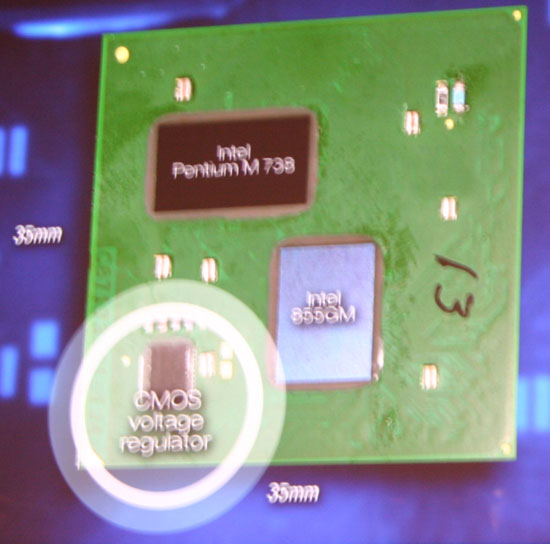
The benefits were two-fold: 1) Intel could manage fine grained voltage regulation with very fast transition times and 2) a tangible reduction in board component count.
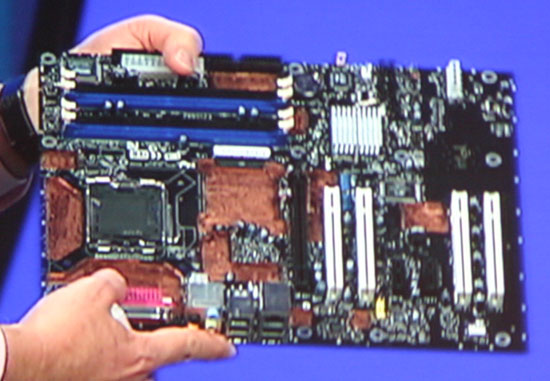
2005 - A prototype motherboard using the technology. Note the lack of voltage regulators on the motherboard and the missing GMCH (North Bridge) chip.
The second benefit is very easy to understand from a mobile perspective. Fewer components on a motherboard means smaller form factors and/or more room for other things (e.g. larger battery volume via a reduction in PCB size).
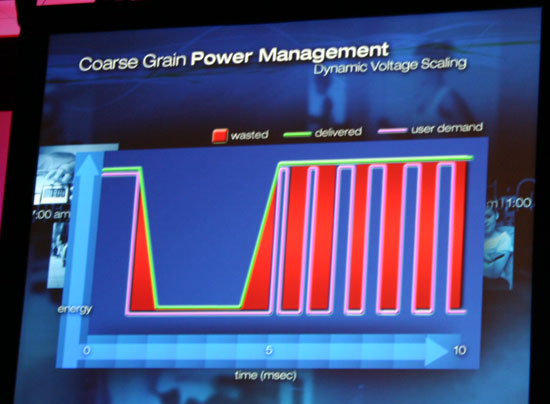

The first benefit made a lot of sense at the time when Intel introduced it, but it makes even more sense when you consider the most dramatic change to Haswell: support for S0ix active idle.


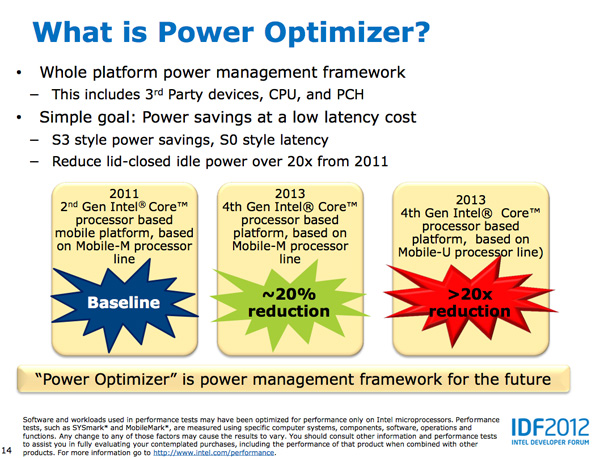
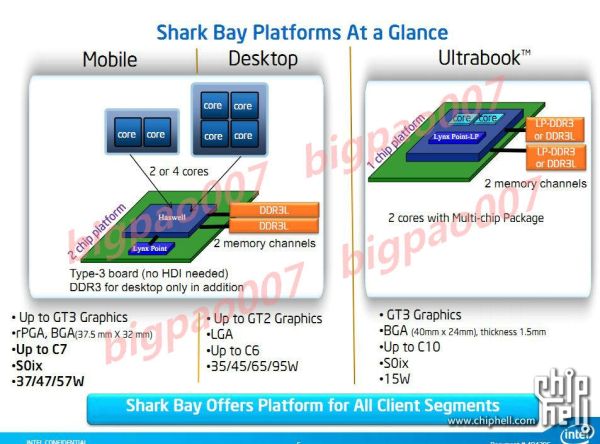








245 Comments
View All Comments
jigglywiggly - Friday, October 5, 2012 - link
wish the onboard gpu was better =/woula been nice for a laptop
tipoo - Friday, October 5, 2012 - link
2x the HD4000 is pretty decent for integrated. I wonder if that's 2x with or without the eDRAM cache though.ElvenLemming - Friday, October 5, 2012 - link
It's been known for a while that Haswell was only going to have a moderate improvement in the iGPU and the next big overhaul would be coming with Broadwell.csroc - Friday, October 5, 2012 - link
This is impressive, it might convince me it's time for a new laptop. On the other hand I also need to build a new desktop workstation and Haswell so far hasn't impressed me in that space.mayankleoboy1 - Friday, October 5, 2012 - link
Is Intel sacrificing Desktop CPU performance to make an architecture that is geared to the mobile space ?csroc - Friday, October 5, 2012 - link
It feels that way to me. Mobile performance seems to be their big concern now, that and improving the GPU. Two things I generally can't be bothered to care about when I'm looking to build a new workstation. I suspect I'll build an Ivy Bridge system because I could use it now and see nothing worth getting excited about.dishayu - Friday, October 5, 2012 - link
I fully share your sentiment. TO be very crude, i don't mind at all, paying for power imporvements, because it will pay back for itself in the long term (by consuming less power AND needing lesser cooling). But i DO mind very much, paying for 40 EUs of GPU on my desktop build which i will not use even for a second. Me, you and many others do not care about on-die graphics and Intel should realize that.I don't know why intel can't offer us both GPU and GPU-less options, the way they did with motherboards back in the days? P965 had no graphics, G965 did. Pretty sure it's technologically not an issue.
DanNeely - Friday, October 5, 2012 - link
If it makes you feel any better; reports elsewhere are that GT3 will be mobile only, because desktops don't have the power/size constraints driving the need for premium IGPs.Intel's not IGP CPUs are the E series parts; unfortunately they've failed to execute on the enthusiast side in terms of price/launch date leaving them as mostly server parts.
There just aren't enough of us to justify Intel adding another die design for their mass market socket that doesn't have an IGP at all instead of just letting us turn it off and use the extra TDP headroom for more time at boost speeds.
Omoronovo - Friday, October 5, 2012 - link
I'm somewhat in disagreement with you both.Whilst I share a concern that Intel is no longer focusing on raw performance improvements in the purely desktop space, they are still delivering incremental updates to the architecture that will benefit all current software (even if only marginally). However, processor performance has been reaching more and more diminishing returns in recent years, namely that software is simply not able to take advantage of multiple cores and improved performance because of (primarily) locks and complexity in creating multi-threaded applications.
As such, Intel has been focusing on that area - to make it easier for software and software developers to take advantage of the performance that exists *now* rather than brute forcing the issue by simply delivering more raw performance (much of which will be wasted/remain idle due to current software constraints).
With this, Intel has been able to focus on keeping performance high whilst subsequently dropping power usage substantially - the fact the iGPU is oftentimes not being used in a desktop environment does not invalidate it's utility - QuickSync is a prime example of where the gpu can accelerate certain types of processing, and if more software takes advantage of this we should see even more gains in future.
For the last 6 years or so, Intel has shown that it knows what demands will be placed on future computing hardware, and they seem convinced that this is the way to go. We might not be there yet, but technologies like C++AMP, OpenCL and such make me hopeful that this will change in a few years.
cmrx64 - Friday, October 5, 2012 - link
I solved this problem by buying an Ivy Bridge Xeon (specifically, an E3-1230v2). No GPU, lower power consumption than the equivalent i5/i7, has hyperthreading, performs really good, and a lot cheaper than an i7.If you don't care about the GPU, look to the Xeon line.